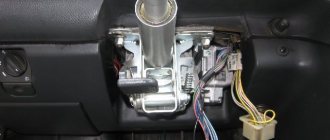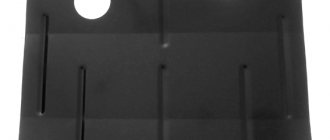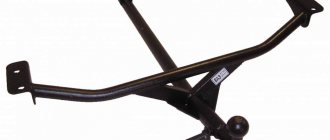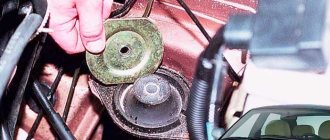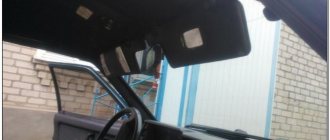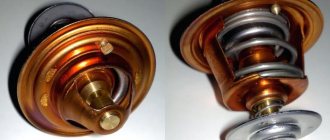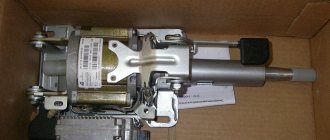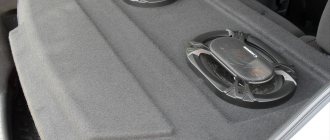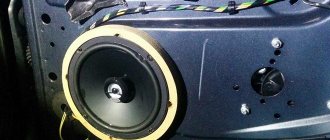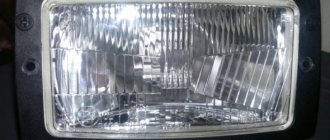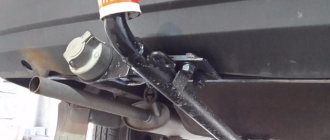Many owners of domestic cars are concerned about the issue of protecting the engine of their car. And all because the plant does not provide for the installation of anything significant.
No, there seems to be protection there. But it is a plastic splash guard. The maximum that it is capable of is protection from minor contacts with the road surface on potholes. Basically, it protects the pan from water and dirt.
Therefore, updating the protection is a mandatory measure, without which there is a high probability that your engine or other hidden components will soon be damaged. And repairs can cost a lot of money. Don't forget the quality of roads most drivers have to deal with.
crankcase protection
ARMOR FOR “TEN”
On cars of the “tenth” family, a mudguard is installed under the engine - a thin (0.7 mm) tin that is unable to protect the engine crankcases and gearboxes from mechanical damage. Its main purpose is to block the path of dirt into the engine compartment and optimize the aerodynamics of the car.
| Such a “shield” will suit only the owner who carefully operates the car in simple conditions. But if you drive onto a bumpy country road, you can pay dearly for not protecting the power unit in time with something more solid. |
What types of protections does trade offer? We toured several metropolitan auto stores and markets. Almost everywhere, sellers know and, accordingly, recommend only one, the most common type of protection - “Tolyatti”. But we discovered two more options.
Let's look at the advantages and disadvantages of all three.
| I - “Tolyatti” defense | II – product of the Samara Metallurgical Company. In addition to the aluminum protection itself, the kit includes two more brackets with mounting screws; |
| III – protection made in St. Petersburg LLC “Metalloproduktsiya”. |
Anyone who has seen how aluminum parts turn into dust over two winters will ask: “Will the protection withstand the second winter in “salty” regions?”
We decided to carry out the simplest tests. Over two days off, a saline solution and battery sulfuric acid were poured onto the surface of Type II protection. On Monday they wiped it with a rag - there were no signs of damage, just barely noticeable stains. But will it be like this after the Moscow or St. Petersburg winter? And in a year or two? Long-term testing will be needed to find out. We will try to carry them out and we will report the results. And the “pieces of iron” (protections I and II) will rust as usual, like any “tin can”, although the quality of the paint from St. Petersburg is higher.
The products also have other disadvantages. Plastic shields are attached to the standard engine splash guard, covering the side of the engine compartment. If you remove the mudguard and install protection, then the shields should be secured to it. However, none of the defenses show this. The lower edges of the shields are loose - this is not great. However, protections I and II can be installed without removing the mudguard. The fastening of the shields will remain the same. But such a layer cake has disadvantages: the airflow of the power unit from below may worsen, dirt and moisture will accumulate between the protection and the mudguard, and stones will get stuck. And there is no need for excess weight.
As the work progressed, we finally solved these problems, and, it seems, successfully. More on this below, but for now let’s start “trying on the armor.”
| Using a 10mm wrench, unscrew the five nuts on the front fastening of the mudguard. | Using two 19mm wrenches, unscrew the nuts on the bolts securing the arms to the car body. |
| We put the protection eyes on the bolts and select suitable washers: they are not included in the kit, but are needed for reliable fastening. |
Tighten the five front fasteners...
| ...and protection I is installed. | Protection II will first have to be assembled by screwing in the lugs (using a Phillips screwdriver and a 13mm wrench). |
| Its installation is similar to option I. |
This is where a tempting idea arose: cut out the central piece of the standard mudguard, leaving only the side parts that protect the engine compartment from dirt and hold the lower edges of the plastic shields.
To do this, remove the standard mudguard.
| Using a “10” wrench, unscrew two screws securing the plastic shields... | ...and one bolt each securing the mudguard to the side members. |
| The front nuts are already unscrewed - and we remove the protection. | Using metal scissors (or a grinder), we cut off the sidewalls. |
| It should look something like this. (Greater precision is not needed here.) | We mount the resulting sidewalls on the car... |
| ...and again set up protection - I or II. |
Removal
1. We prepare the car for repair work.
2. Using a 10 mm socket wrench with a deep head, unscrew the five self-locking nuts (1) of the front fastening of the protection.
3. Using an 8 mm socket wrench, unscrew the four self-tapping screws (2) securing the engine protection to the mudguards of the engine compartment.
4. Using a 10 mm socket wrench, unscrew the two bolts (3) of the rear protection fastening.
5. We disengage the engine protection from the mudguards and remove it from the car.
Why are impacts to the bottom dangerous?
Damaging the crankcase for a VAZ 2110 is not a difficult matter. For most owners of this model, it is more a matter of time or simple luck.
In this case, the engine can be seriously damaged due to imperfections in the design of the engine suspension. Essentially, the power unit hangs as you do.
- The engine oil pan is too low to the ground.
- When moving, the motor moves slightly, but moves on the mounting brackets. This is especially true for situations with sudden braking.
- Even a small stone hitting a pan at speed can cause serious damage. Then the repair will cost much more than installing protection.
In order to prevent unnecessary movement of the engine, experts recommend installing an additional fixing bracket. It holds the motor better, but still does not provide protection from impacts.
Possible malfunctions during a crankcase impact
1. A significant dent on the oil pan, but without a visible breakdown.
Don't be complacent if you can't see any oil leaks.
It is very likely that the oil breather (also known as the oil receiver) broke off during a sharp impact.
The breather on a VAZ injector is most often made of aluminum alloy or plastic. The breather has an oil intake tube, which is about 5 cm higher than the sump. Therefore, the place where the breather tube broke off may be above the oil level. First of all, in the event of a sharp impact with a visible dent, the engine must be turned off immediately.
Carter with a significant dent
Checking whether the breather has broken off is carried out as follows:
- Perform a test run of the engine. At the same time, if the oil pressure sensor light on the control panel lights up and does not go out, you can suspect a broken breather;
- Turn off the engine;
- Add oil and start the engine again. If an oil stain appears under the car, it means that the breather has failed, you just need to call a tow truck. If the pressure light in the control unit goes out, there is hope that the breather withstood the blow, you can carefully move under your own power. Preferably, not home, but to a car service center. But it’s still better to use a tow truck. You should be aware that in this case, repairs may be limited to the fact that the breather will be replaced. This is not so easy to do, but it is still better than overhauling the entire engine.
2. Minor dent, no breakdown observed.
It is unlikely that such a malfunction will cause the breather to break off, but the reduced gap between the breather and the pan will greatly reduce the vehicle's capabilities under high loads.
These malfunctions threaten oil starvation, which always ends sadly for the engine. However, the injection car VAZ 2110 from AvtoVAZ, let's be honest, has a rather primitive control system, and the sensors send little information to the control unit.
New oil pan
It is often not enough to fix the error code. Thus, the injector, being a more progressive system, is inferior here to the old system - a pressure gauge, which shows the increase or decrease in oil pressure as the speed increases or decreases.
However, if the sensor indicator light on the control panel does not light up, you can slowly move to the repair site. Remove the pan, straighten it or replace it, and check the breather at the same time.
3. Crankcase breakdown.
If the mudguard and pan are broken, and there is a puddle of oil under the car, do not even think about starting the engine. The faster you silence it, the less harm you will do to it. Only tow truck and further troubleshooting.
Possible problems
There are several situations when the crankcase hits the road surface. Their consequences can be very different.
Therefore, let's look at the most common situations and determine what you, as the driver and owner of the car, should do.
A dent has formed, but the breakdown is not visible
There is a high probability that as a result of such damage the breather, that is, the oil receiver, has broken.
You should not rejoice prematurely if no traces of oil leaks are found after the impact.
Installation
We install the engine protection and all previously removed parts on the car in reverse order.
Attaching the engine protection to the car.
Hello, today we will tell you how to remove and replace the engine protection on a VAZ 2110, 2111, 2112. When you change the oil in the engine, gearbox, or you have severely bent this protection, or perform any other operation from below the car, you will need to remove the engine protection.
Many owners of domestic cars are concerned about the issue of protecting the engine of their car. And all because the plant does not provide for the installation of anything significant.
No, there seems to be protection there. But it is a plastic splash guard. The maximum that it is capable of is protection from minor contacts with the road surface on potholes. Basically, it protects the pan from water and dirt.
Therefore, updating the protection is a mandatory measure, without which there is a high probability that your engine or other hidden components will soon be damaged. And repairs can cost a lot of money. Don't forget the quality of roads most drivers have to deal with.
Choice of protection
To ensure proper protection for your own engine on a VAZ 2110, you must first decide which element will be installed on the bottom of the car.
Today, manufacturers offer many options. Let’s identify the most popular solutions in the case of the domestic “ten” and discuss their features. This will help you make the final decision specifically for your situation.
Type of protection
Peculiarities
Aluminum alloy guard
Lightweight, quite reliable and durable. No special mounting brackets are required for installation. Typically, the available fasteners are excellent for fixing
Steel protection with powder paint
Such elements are durable and have good corrosion resistance. However, they are characterized by a significant drawback - the metal is too thin, so do not expect reliable protection
Protection of KAMAZ production
This is the thickest protection option, where metal is used with a thickness of about 4 millimeters. They are distinguished by reliability and heavy weight. Due to the mass, a serious drawback arises - the fasteners can simply break out with all the consequences. Therefore, for installation it is imperative to use special high-strength brackets
Be sure to choose steel that is at least 2 millimeters thick. At the same time, the presence of stamped stiffeners is also strongly recommended.
When purchasing protection, be sure to pay attention to the presence of special technological holes through which oil is drained from the crankcase and airflow is provided to the power unit. Fasteners only in full compliance with the holes provided on the VAZ 2110.
"Sheriff" comes to the rescue
In our case, “Sheriff” is not an American police officer, but the name of a company engaged in the production of relatively inexpensive and high-quality protection. The first protective “chain mail” Sheriff for engine crankcases of various models appeared back in the 90s of the last century.
Today, the company’s catalog includes about 1,600 crankcase protection options made from various materials. Similar products from other manufacturers are inferior, first of all, in the combination of price and quality. Although there are some very interesting options. For example, protection made of titanium or composite materials.
The VAZ 2110 is traditionally equipped with Sheriff products made of 2 mm steel. As practice shows, this is quite enough to ensure effective protection of the car crankcase. It promotes:
- insulating the engine compartment from dust, dirt, water;
- noise insulation;
- protecting the pallet from mechanical damage;
- ventilation of the crankcase and the entire engine compartment.
At the same time, the Sheriff protection is quickly and reliably fixed in the standard holes of the car using reliable fasteners.
In order to remove and install Sheriff, you will need a minimum of tools and about 10-15 minutes of time. Therefore, if you don’t want to go to a service station, then you can handle it on your own.
Replacement
The first thing you need to decide before replacing the protection is whether to keep the factory mudguard or not.
Dismantling works
Some believe that it is better to leave it, since this will provide double protection. Others are of the opinion that such layers of protection do not provide additional protective measures, but only collect dirt and accumulate snow and ice in the winter. The choice is yours.
But just in case, we will tell you how to correctly and quickly remove the factory mudguard from the pan of your car:
- The best option for working conditions is a lift. But if it is not there, you can use an overpass, or an ordinary pit in your own garage;
- Five self-locking nuts are used to secure the front of the factory mudguard. To dismantle them, you will need a regular 10 mm wrench;
- The protection is attached to the mudguards using four self-tapping screws. To remove them, a key of 8 millimeters is useful;
- There are two more mounting bolts at the rear. Here again we pick up a 10 mm key;
- After dismantling all the fasteners, all that remains is to pull the mudguard out of the engagement into which it fits with the mudguards.
Final assembly
That's it, the mudguard has been dismantled, so you can safely proceed directly to installing the newly purchased, new full-fledged protection.
- A pit, overpass or lift is suitable for work. Someone here already has what.
- Place the guard against the surface of the engine sump to ensure it fits into the existing holes.
- Screw the front mudguards to the protection.
- Next, self-tapping screws are attached to the side member brackets.
- The next step is to attach the protection to the mudguards.
- On the front bumper, all that remains is to tighten the five nuts that will finally hold the new metal plate in place.
Working under the bottom
Expert advice. If you want to make driving your own car more comfortable and enjoyable, consider installing a powertrain mounting bracket. It is mounted regardless of what type of protection you have chosen for your VAZ 2110.
Theme Options
Search by topic
Removing the mudguard
If you decide to remove the mudguard before installing the “full” crankcase protection on a VAZ injector, doing it yourself is absolutely simple, just:
- It is best to carry out the work on a lift, but it is also possible on an overpass or pit;
- It is attached to the front on the heel of the nuts (self-locking). They are unscrewed with a 10 key;
- The mudguard is attached to the mudguards with 4 self-tapping screws (8 key);
- and at the back - unscrew 2 bolts with a 10mm wrench;
- After unscrewing, all that remains is to remove the mudguard from its engagement with the shields.
Regardless of the protection you choose, you can also install the engine mounting bracket (if you see the need for it). This will make driving more comfortable.
Source
Why do you need routine and major engine repairs?
As already mentioned, current repair work should be understood as the procedure for disassembling and assembling a vehicle engine with the subsequent replacement of some parts. Most often, replacements and upgrades require components such as:
- liners - main and connecting rod;
- piston rings;
- valve seals.
These replacements are a necessity, albeit periodic. They will not only increase engine resources, but also change the quality of its operation.
